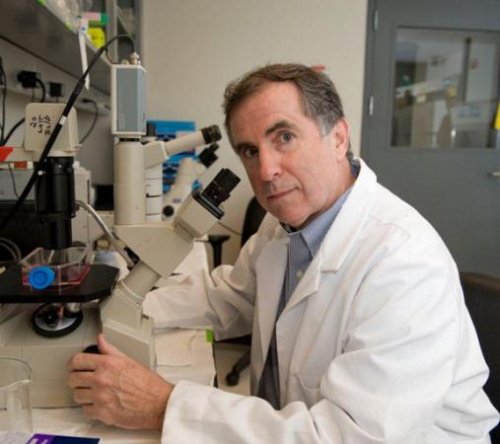Brown licenses potential muscular dystrophy treatment to Tivorsan Pharmaceuticals
Brown licenses potential muscular dystrophy treatment to Tivorsan Pharmaceuticals
Duchenne muscular dystrophy affects only young boys, who begin to show symptoms when they are of preschool age. The disease is invariably fatal. Justin Fallon has led a research team that has developed a novel therapy in mice. Brown University has licensed the technology to Tivorsan Pharamaceuticals, hoping to spur development of a treatment for humans.

Hope for Duchenne muscular dystrophy. A team led by Justin Fallon has tested a novel therapy in mice. Brown University has licensed the technology in hopes of developing a treatment for thousands of young boys diagnosed every year. Credit: Peter Goldberg
PROVIDENCE, R.I. [Brown University] — Development of a potential treatment for the most common form of muscular dystrophy is moving into a new phase at Brown University. Brown has granted an exclusive license for the intellectual property to Tivorsan Pharmaceuticals, a startup firm that will strive to see it through human trials.
Officials from Tivorsan and Brown will meet on campus today (Monday, Sept. 20, 2010) to mark the start of this next phase of the potential treatment’s development.
In mice, the treatment, based on a protein called biglycan, has slowed by 50 percent the kind of muscle damage that is thought to be the cause of muscle deterioration in boys with Duchenne muscular dystrophy (DMD), said Justin Fallon, professor of neuroscience, who has led the research. In DMD, which affects one in every 3,500 boys, sufferers are consigned to an incurable fate in which scar tissue and fat replace almost every skeletal muscle in their body. Patients inevitably die, typically by the time they are in their 20s.
“At this point we cannot say how effective biglycan will be in humans, however the results from the mouse studies are encouraging,” said Fallon, who is affiliated with the Brown Institute for Brain Science. “We are seeking an effective treatment that gives boys a better quality of life for years. We hope to prolong the time they can walk without assistance and perform the activities they enjoy doing most.”
Joel Braunstein, one of the Tivorsan founders and acting CEO, said the company will raise the money and hire the expert staff to see biglycan through the through the drug development and government regulatory review and approval processes.
“We have a challenging road ahead of us but we are firmly committed to working toward testing the safety and efficacy of biglycan in humans,” said Braunstein, a physician and principal at LifeTech Research in Baltimore. “We deeply acknowledge the need and urgency for a new treatment in DMD. If biglycan proves safe and effective in human testing, the potential exists for providing relief to thousands of boys and their families around the world.”
Fallon serves as chair of Tivorsan’s scientific advisory boaard.
Developing biglycan
In 2000 a team led by Fallon began to accumulate evidence that biglycan, which is produced naturally in the body, regulates the production of a protein called utrophin. Utrophin, discovered in 1989, stimulates the body to repair muscle damage, just like dystrophin, the protein that DMD-afflicted boys are genetically unable to produce.
All young children produce utrophin, but they produce much less of it naturally as they get older.
“In normal individuals that’s fine because dystrophin is there, but in a Duchenne boy there is no hand-off,” Fallon said. “The baton is dropped.”
That dropped hand-off helps explain why DMD doesn’t begin to show up in boys until they are preschoolers and why they still retain enough strength to walk on their own until they are preteens.
Further research by Fallon and research associate Beth McKechnie revealed that biglycan is rare in its class of proteins because the physiologically active form can be manufactured relatively easily using recombinant lab techniques. In the last several years, Fallon’s research group, including former research associate Mary Lynn Mercado and current research associates Alison Amenta and Michelle Dechene, have been testing and refining the use of biglycan in DMD mice.
Partners prepared to fight
The research has gone well enough that last year Fallon won a four-year, $5.2-million grant from the National Institutes of Health to advance the development of biglycan as a novel potential therapy.
Fallon also won funding from foundations dedicated to fighting DMD. Last year Parent Project Muscular Dystrophy awarded him its End Duchenne Award. Charley’s Fund has also funded Fallon’s research.
“DMD is an unrelenting disease, but between Brown, Tivorsan, Charley’s Fund and the NIH, we have a strong set of partners prepared to fight,” Braunstein said.
* The above story is reprinted from materials provided by Brown University
** More information at Brown University (Providence, Rhode Island, USA)




















